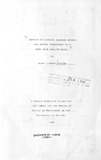Aspects Of Climate, Herbage Growth And Animal Production In A Semi-arid Area Of Kenya
Abstract
The results obtained from two major field
experiments conducted on a natural range land sward
in a semi-arid area of Kenya are presented and
discussed in relation to other relevant work.
In the cutting trial 15 different combinations
of cutting height and frequency were used
to examine the effects of defoliation on the
productivity and persistence of the natural sward.
Over 10 growing seasons even the most severe of
the treatments, in which the sward was cut every
three weeks at 5cm height did not appear to cause
irreversible decline in sward vigour in the
absence of the grazing animal.
Highest overall herbage yields were
obtained with the relatively severe defoliation
treatment of six-weekly cutting at 5cm height. A
multiple regression model relating the herbage
production to rainfall in the present, previous
and penultimate three-week periods before cutting
accounted for 62% of the variation in yield.
No advantage was found in using estimates of
actual evapotranspiration rather than rainfall in
the regression. The role of such a model in
the prediction of long term forage productivity
and potential animal performance is also discussed.
The grazing trial examined the performance
of groups of beef steers under set stocking at
two. three. four and five hectares per animal.
over an eight year period. Performance per
animal was relatively unaffected by stocking rate.
with an overall growth rate of about 350g live weight
gain per day over the whole study period.
Growth rate at anyone time was found to be
directly relatable to sward condition. which in
itself was related to climatic season.
Evidence is presented that the crossbred animals
used were very selective in their grazing. especially
in the dry season. so that provided adequate
forage was available within which selection could
be effective. reduction in grazing intensity did
not lead to improvement in diet intake quality or
quantity.
The difficulties of estimation of diet
quality and intake levels are discussed in
relation to the present and other relevant studies.
particularly with reference to the use of internal
markers for estimation of diet digestibility.
The role of mathematical models in the
examination of the climate/vegetation/animal
complex is discussed and some of the problems
associated with their use are examined.
suggestions are made for areas of work
considered to be priorities for future attention
to assist in improving the management and animal
productivity of the semi-arid areas. Attention
is given to the need for research information to
support the change in land use in such areas from
low population-density nomadism to a sedentarised
production system, which is required to support a
higher level of human population
Citation
Doctor of Philosophy, University of Nairobi, 1985.Publisher
University of Nairobi. Faculty of Agriculture

